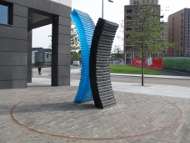Simon Hitchens' 'Unity'
Date uploaded: December 18, 2013
Simon Hitchens’ new sculpture at King’s Cross not only references the area’s industrial past but also celebrates its future.
The redevelopment of the former King’s Cross Goods Yard, now known as King’s Cross Central, incorporates a contemporary element alongside the Victorian buildings which remain on the site, including the University of the Arts London’s (formerly Central Saint Martins) newly restored Granary Complex.
The sculpture, Unity, was commissioned by Art Contact on behalf of the developers, urnabest. The brief called for a site-specific sculpture connecting the history of the site to the new buildings.
Unity stands at the entrance to Urbanest’s landmark tower on the northern edge of the King’s Cross Central regeneration site. The entrance forecourt to this high spec student accommodation building, is an important junction within the site where the sculpture creates a focal point. It helps to create a sense of place within the new community as well as providing a link with the past.
Unity is a bold, abstract sculpture, which suggests two large redundant cogged wheels.
Hitchens said: “Imagine two giant cogged wheels, slowly turning to move a lock gate, for example. These old wheels, now broken, have sunk into the ground. What is left is protruding from the paved surface.
“I chose the materials to add to the industrial feeling of the sculpture: hard-wearing and robust granite which has been used in the fabrication of structures and surfaces throughout the site, contrasting with cast blue resin. My aim was to create something that would have visual impact and authority, holding its own against the surrounding architecture, celebrating the past yet complementing the present.”
One part of the sculpture is a solid curved slab of dark grey granite. It stands back to back with a similar shaped, taller slab of cast blue resin. The granite element symbolises the robust building materials used in the old goods yards, where commodities were moved about by rail and cart. It was shaped from a huge block of stone by drilling parallel holes and then carving the shape with a three-metre circular saw.
The more technologically challenging blue resin element hints at the nearby Regent’s Canal and the important part it played in the transport of goods. The contemporary feel of this material also references the future cultural aspirations for the site.
Standing 3.75 metres tall, the blue resin curve is noticeably taller than the granite one, which reaches a height of 3.25 metres. The parallel drilled holes on the curved surfaces of the granite create a texture which echoes the horizontal window bands running around building outside which the sculpture stands. These ridges are a perfect jigsaw fit to the resin curved form, which has been directly cast from the surface of the shaped granite. In contrast to the rough textured curved faces, the narrow sides of both curved forms are smooth to touch, with industrially milled surfaces. The graphic form of the sculpture is recognisable as a stylised X – King’s X, articulating a unity between two separate yet co-dependant bodies.

